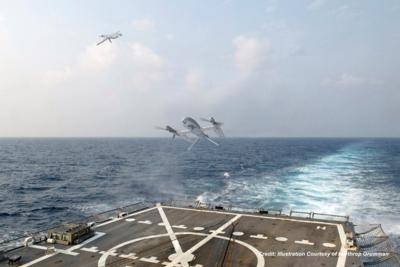Sun, Jul 30, 2023
Northrop Grumman Contracted for Next-Gen Seaborne VTOL UAV Beyond Current Market Capability
The Defense Advanced Research Project Agency’s (DARPA) Tactical Technology Office has contracted with Northrop Grumman to design an autonomous VTOL aircraft system for use in US Navy ships while underway, slated to carry a 60-lb payload for more than 20 hours of flight time.

The contract illustrates the relatively empty field in that particular tactical niche, one that has been addressed through more traditionally designed, helicopter-like UAVs abroad. Naval aviation is often a difficult realm of design and operations, combining a moving takeoff and landing platform with the fueling constraints of operations beyond convenient, abundant supply lines - and that's leaving out the harsh impacts of landing in rough seas. While General Atomics has made some headway in adapting its existing MQ-9 platform to oceanic operations, their mods basically amount to a STOL kit for improved takeoff performance on carriers. The Schiebel Camcopter S-100 has seen increasing use overseas, but its wankel engine limits endurance to a bit more than 6 hours with a 75-lb payload, making fall short of the 20-hour contract requirement.
Grumman hopes its AdvaNced airCraft Infrastructure-Less Launch And RecoverY (or, in typical MIL fashion, "ANCILLARY") demonstrator will fit the bill as a "cost-efficient, multiple-mission capable vehicle built on an agile platform that is runway independent." It believes the Ancillary platform will be "capable of carrying a large 60-pound sensor payload with greater endurance of 20 hours’ time on station and mission radius range of 100 nautical miles", while noting that such specs exceed current systems. Additional goals include the ability to land in adverse weather conditions. Its mission will be the usual blend of ISR, targeting, and expeditionary support one would expect of a little whirlybird at sea, as they've all been since the original U-Boat rotor kites took to the skies in WWII. Of course, the new equipment will be far more effective, but it's interesting to note that the tactical lineage is there - ships want a pair of eyes they can launch themselves.
Northrop Grumman VP of research and advanced design Tim Frei made sure to weigh in on the situation with a generically encouraging pull quote, saying the firm will work with DARPA "to significantly enhance how future autonomous vertical lift aircraft will operate at sea and ashore. The ANCILLARY program enables us to combine our digital engineering expertise with extensive knowledge and insights from past successes in developing and operating uncrewed vertical lift aircraft for the U.S. Navy.”
More News
LinxUs System Adds Capabilities for Data-Driven Operators Textron Aviation announced another option for operators processing their post-flight data, adding interoperability with GE>[...]
Aero Linx: The de Havilland Moth Club Ltd The de Havilland Moth Club evolved from a belief that an association of owners and operators of Moth aeroplanes should be formed to create>[...]
(Pilot) Inadvertently Applied Excessive Braking Action, And The Airplane Nosed Over Analysis: The pilot reported that, while landing at a remote, rough and uneven airstrip in a tai>[...]
“MCADT is committed to rapidly integrating armed first-person view drones into the FMF, enhancing small-unit lethality and providing organic capabilities that warfighters cur>[...]
From 2017 (YouTube Edition): Major Engine Supplier Joins Forces With Small Aircraft Manufacturer… GE recently made an agreement with Venom Aircraft to supply engines for the>[...]
 Citation Operators Get Another Flight Data Connection for QA
Citation Operators Get Another Flight Data Connection for QA ANN's Daily Aero-Linx (06.01.25)
ANN's Daily Aero-Linx (06.01.25) NTSB Final Report: Bellanca 8GCBC
NTSB Final Report: Bellanca 8GCBC Aero-News: Quote of the Day (06.01.25)
Aero-News: Quote of the Day (06.01.25) Classic Aero-TV: High-Speed Match-up - Venom and GE Rebirth A Legend
Classic Aero-TV: High-Speed Match-up - Venom and GE Rebirth A Legend



